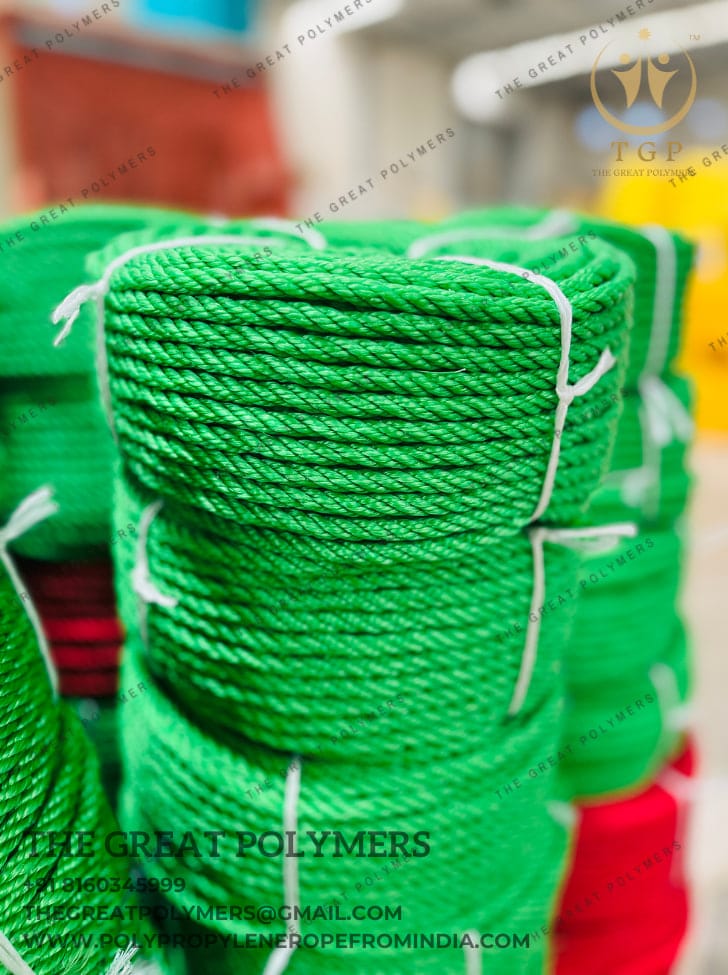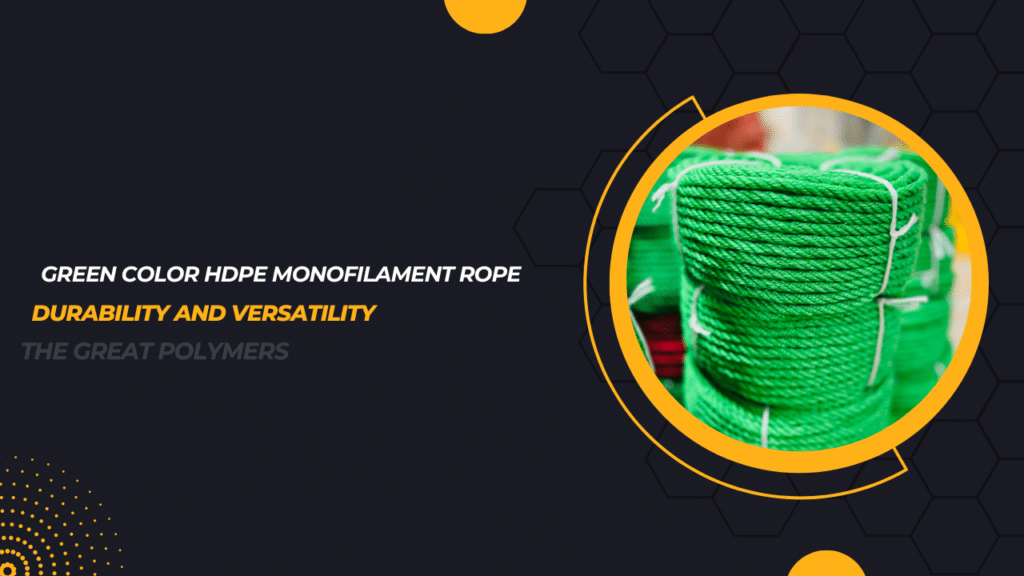HDPE (High-Density Polyethylene) monofilament ropes are versatile and widely used in various industries due to their exceptional properties and durability. In this article, we’ll explore the features, uses, advantages, and considerations related to green color HDPE monofilament ropes.
Introduction to HDPE Monofilament Rope
HDPE monofilament ropes are made from high-density polyethylene, a thermoplastic polymer known for its strength and durability. These ropes are produced by extruding molten plastic through a die to form a single continuous filament. The resulting rope is lightweight yet incredibly strong, making it ideal for a wide range of applications.
Properties of HDPE Monofilament Rope
Lightweight
One of the key advantages of HDPE monofilament rope is its lightweight nature. Despite being strong and durable, HDPE ropes are easy to handle and manipulate, making them suitable for various tasks.
High Strength
HDPE monofilament ropes boast excellent tensile strength, allowing them to withstand heavy loads without stretching or breaking. This strength makes them ideal for demanding applications where reliability is crucial.
Chemical Resistance
HDPE monofilament ropes are highly resistant to chemicals, including acids, alkalis, and solvents. This resistance makes them suitable for use in corrosive environments such as marine settings or industrial facilities.
Uses of HDPE Monofilament Rope
HDPE monofilament ropes find applications across various industries due to their versatility and durability. Some common uses include:
Marine Applications
In the maritime industry, HDPE monofilament ropes are used for mooring, towing, and anchoring vessels. Their strength, buoyancy, and resistance to saltwater corrosion make them indispensable for maritime operations.
Agriculture
In agriculture, HDPE monofilament ropes are utilized for trellising, fencing, and crop support. Their durability and resistance to environmental factors make them ideal for outdoor agricultural applications.
Construction
In the construction industry, HDPE monofilament ropes are used for scaffolding, safety netting, and lifting. Their strength and reliability make them essential for securing loads and ensuring worker safety on construction sites.

Advantages of Green Color HDPE Monofilament Rope
Visibility
The green color of HDPE monofilament ropes enhances their visibility, making them easier to spot in various environments. This increased visibility improves safety and reduces the risk of accidents, especially in low-light conditions.
UV Resistance
HDPE monofilament ropes are resistant to ultraviolet (UV) radiation, ensuring prolonged exposure to sunlight without degradation. This UV resistance extends the lifespan of the rope, making it suitable for outdoor applications.
Comparison with Other Rope Materials
When compared to other rope materials such as nylon and polyester, HDPE monofilament ropes offer several advantages:
Nylon Rope
While nylon ropes are known for their elasticity and shock absorption, HDPE monofilament ropes excel in strength and durability. HDPE ropes are less prone to stretching and have a higher tensile strength, making them suitable for heavy-duty applications.
Polyester Rope
Polyester ropes are valued for their resistance to moisture and abrasion. However, HDPE monofilament ropes offer superior chemical resistance and UV stability, making them more suitable for harsh environments.
Factors to Consider When Choosing HDPE Monofilament Rope
When selecting HDPE monofilament rope for a specific application, several factors should be taken into account:
Diameter
The diameter of the rope determines its strength and load-bearing capacity. Thicker ropes have higher tensile strength but may be less flexible than thinner ropes.
Length
The length of the rope should match the requirements of the intended task. Consider the distance between anchor points and any additional slack needed for tying knots or securing loads.
Load Capacity
Ensure that the chosen rope can support the expected load without risk of failure or stretching. Consider factors such as weight distribution and dynamic forces when calculating the load capacity.
Maintenance and Care Tips
To prolong the lifespan of HDPE monofilament rope and ensure safe operation, follow these maintenance and care tips:
Cleaning
Regularly clean the rope with mild soap and water to remove dirt, debris, and contaminants. Avoid harsh chemicals that may degrade the rope’s material.
Storage
Store the rope in a cool, dry place away from direct sunlight and moisture. Coil the rope neatly to prevent kinks and tangles that could weaken its structure.
Inspection
Inspect the rope regularly for signs of wear, fraying, or damage. Replace any worn or damaged sections to prevent accidents and ensure reliable performance.
Safety Precautions
When using HDPE monofilament rope, observe the following safety precautions to prevent accidents and injuries:
Weight Limits
Do not exceed the recommended weight capacity of the rope to avoid overloading and potential failure. Use additional support or reinforcement for heavier loads.
Proper Knot Tying
Ensure that knots are tied correctly and securely to prevent slippage or unraveling. Use appropriate knotting techniques for the specific application and load requirements.
Avoiding Abrasions
Protect the rope from sharp edges, rough surfaces, and abrasive materials that could cause friction and abrasion. Use protective sleeves or padding as needed to prevent damage.
Environmental Impact of HDPE Monofilament Rope
Despite their durability, HDPE monofilament ropes have environmental considerations:
Recyclability
HDPE is a recyclable material, but recycling options for used ropes may be limited. Explore local recycling programs or repurposing opportunities to minimize waste.
Eco-Friendly Alternatives
Consider eco-friendly alternatives to traditional HDPE monofilament ropes, such as biodegradable or sustainably sourced materials. These options offer reduced environmental impact without compromising performance.
Conclusion
Green color HDPE monofilament ropes offer a versatile and durable solution for various applications, including marine, agricultural, and construction. With their lightweight design, high strength, and chemical resistance, these ropes provide reliable performance in demanding environments. By following proper maintenance and safety practices, users can maximize the lifespan and effectiveness of HDPE monofilament ropes while minimizing environmental impact.
FAQs
- Can HDPE monofilament ropes be used in saltwater environments?
- Yes, HDPE monofilament ropes are resistant to saltwater corrosion and are commonly used in marine applications.
- How do I determine the appropriate diameter of HDPE monofilament rope for my needs?
- Consider factors such as load capacity, flexibility, and space constraints when selecting the diameter of HDPE monofilament rope.
- Are HDPE monofilament ropes suitable for heavy lifting applications?
- Yes, HDPE monofilament ropes have high tensile strength and are suitable for heavy lifting tasks when used within their weight capacity limits.
- Can HDPE monofilament ropes be spliced?
- Yes, HDPE monofilament ropes can be spliced using appropriate techniques to create strong and reliable connections.
- Are there any disposal considerations for used HDPE monofilament ropes?
- While HDPE is recyclable, options for recycling used ropes may vary depending on local facilities and regulations. Explore recycling programs or repurposing options to minimize waste.


